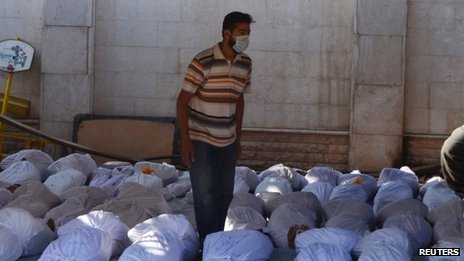
Hundreds of Syrians have been killed early this morning on the outskirts of Damascus following chemical weapons attacks, Syrian opposition activists say.
Rockets with toxic agents were launched at the suburbs of the Ghouta region early on Wednesday as part of a major bombardment on rebel forces, they say.
The Syrian army says the accusations have been fabricated to cover up rebel losses.
The main opposition alliance said that more than 1,000 people were killed by the attacks.
Activist networks also reported death tolls in the hundreds, but these could not be independently confirmed.
It is also not clear how many died in the bombardment of the sites and how many deaths were due to any exposure to toxic substances.
Images showed dozens of bodies with no visible signs of injuries, including small children, laid out on the floor of a clinic.
In a statement, the army described the accusations of chemical weapons use as grave, and stressed the military’s right to fight what it described as terrorism in Syria.
It accused the opposition of fabricating the accusations to divert attention from the huge losses its forces had suffered recently.

UK Foreign Secretary William Hague and French President Francois Hollande called for UN inspectors to be allowed access to the area and said Britain and France would raise the issue at the UN.
If confirmed, the attacks would mark a “shocking escalation in the use of chemical weapons in Syria”, William Hague said.
The Arab League echoed the call for the inspectors to go to the site, while Saudi Arabia called for the UN Security Council to convene immediately to discuss the matter.
The attack took place as part of a heavy government bombardment of the region surrounding Damascus, where government forces have been trying to drive out rebel forces.
Casualties were reported in the areas of Irbin, Duma and Muadhamiya among others, activists said.
Footage uploaded to YouTube from the scene by activists shows many people being treated in makeshift hospitals.
The videos show victims, including many children, having convulsions. Others are apparently immobile and have difficulty breathing.
“Many of the casualties are women and children. They arrived with their pupils dilated, cold limbs and foam in their mouths,” a nurse at a Duma medical facility, Bayan Baker, told Reuters.
The number of casualties is much higher than in previous allegations of chemical weapons attacks.
The Sana news agency said the reports of the attack were “baseless”, quoting a “media source”.
The reports were “an attempt to divert the UN chemical weapons investigation commission away from carrying out its duties”, Sana said.
The head of the inspection mission, Ake Sellstrom, said he had seen TV footage of the latest attack but nothing more.
“It sounds like something that should be looked into,” Ake Sellstrom told the Swedish TT news agency.
Ake Sellstrom said that whether his team went to the scene would depend on whether any UN member state went to the UN Secretary General and asked them to.
The inspectors arrived on Sunday and are due to investigate three other locations, including the northern town of Khan al-Assal, where some 26 people were killed in March.
Both the rebels and government forces have accused each other of using chemical weapons during the conflict.
It has not been possible to independently verify the claims.
In July 2012, the Syrian government implicitly admitted what had long been suspected by experts in the field of chemical weapons proliferation – that Syria had stocks of chemical weapons.
Experts believe it has large undeclared stockpiles of mustard gas and sarin nerve agent.
Damascus said the weapons, stored and secured by the armed forces, would never be used “inside Syria”, but could be used against an external attack.
[youtube 1WTAQ5_e52U]